
Beechen Cliff, 1734 print

Beechen Cliff, 1734 print
The City is built between hills. The river curls round it, embracing the Abbey, the Town Hall, the streets and squares of the centre. Beyond the centre the City stretches up the south-facing slopes, laid out in lesser squares and streets of fine Palladian houses and imposing crescents. From where I often pause on the hill to the south of the City, beech woods behind me and a grassy slope falling steeply down to the cemetery below me, I can see the Circus like a miniature Roman amphitheatre linked by a street of tall pale houses to the semi-circle of the Great Crescent . . .
Isabel Colegate, The Summer of The Royal Visit
The past is another country
We stood high above Bath looking down. It had been an arduous climb. About a third of the way up my husband, Jim, had suddenly suggested 'maybe we should have gone round'. Even our sturdy sixteen- year old daughter, Isabel, might not have made it up had not a stairway moulded out of the hill's earth and stones, to which continuous wooden rails were attached, been provided by some prescient civic body. Northanger Abbey had not conveyed how steep this hill really was. I had attributed Catherine Morland's satisfaction on Beechen Cliff almost wholly to the lingering memory of a hard-won battle: to go on this country walk with her real friends she had had to fend off the pressure and deceits practised upon her by a brother and two false friends. Also unemphatically in the text then was the achievement of the walk itself. And unlike another famous eighteenth-century walker, Jean-Jacques Rousseau, Catherine had gotten to share her reveries with congenial spirits.2
The reader would laugh could I say for how long I had almost let myself dream of standing on this green hill so that I too could reject 'the whole city of Bath, as unworthy to make part of a landscape' (NA, 111) with the splendid effortlessness of a touchingly innocent heroine.3 My memory of this initiating time remains indistinct: I cannot recall exactly when I first read Northanger Abbey and conceived this half self-teasing desire. It had to have been before I was 21 because in that year I took a college course in which a professor assigned Emma, and I remember recognising Emma as the only one of the six I had not yet read. It had also to have been after I was 15 because in that year I read Mansfield Park for the first time, and remember knowing that before Mansfield Park of Austen's novels I had read only Pride and Prejudice and Sense and Sensibility. My guess is I first read Northanger Abbey 40 years ago or between the ages of 17 and 19 and I can't remember the experience because these were very difficult years for me from which I remember very little. These were years in which I seem never to have slept and during which time I was anorexic. I do have a vague memory that I first read Northanger Abbey in one of those editions where it is found bound together with Persuasion, as sister-novels.
This desire or dream had been of the ironic kind, one intrinsic to Austen's comedy. My playful yearning to re-enact Catherine Morland's moment came from a persuasion I had that it was most improbable I would ever get the chance. In Austen there is always this sly insinuation that the comically idyllic moment of a novel is so satisying because it is beyond our ken. As her narrator tells us early in Sense and Sensibility, 'the sanguine expectation of happiness . . . is happiness itself' (8). The dreams her texts invite us to wish for can sweeten life only if we do not desire them too strongly.
Once up there I realised I had missed something else. I had not attended sufficiently to the joke that Catherine was taking her friends' strictures drawn from picturesque theory far too solemnly. Bath is indeed fit to be the subject of a picture. To use the phrase of John Wood the elder, one of the men responsible for the way the city of Bath looked towards the close of the eighteenth-century, from this 'stupendous cliff', we could see the river winding through Bath and the bridges that cross this river, the sixteenth-century Abbey, the outside of the buildings that contained the excavated Roman baths, and the many terraces of eighteenth-century buildings which did form circles and half-circles which themselves progressed along that Hogarthian perfection of beauty, serpentine lines.4 We could make out green parks, the streets we had walked on, the Gothic Revival churches inside the city and Regency villas just beyond it, the Assembly rooms, the Parades, Prior Park to the back of us, and yes, right below us, twentieth-century boxes, private residences, parking garages, and shopping malls, roadways filled with moving cars, and the splendid Victorian railway building in which we had found an Internet Café where Isabel had logged on and talked to her friends far away while we sat and had coffee and looked at reprints of garishly-coloured twentieth- century Fauve paintings amidst the bric-á-brac of a self-consciously Edwardian pub.
We had come to Bath and intended to drive through Somerset and go on to the coastal towns of Devon and Dorset to look at as many places as we could that Jane Austen had named, described, visited and lived in. We also hoped to find where Fanny Burney d'Arblay and Ann Ward Radcliffe, Austen's contemporaries, novelists whose work much influenced hers, had lived while they were in Bath. We had seven days and nights.
It had been easy to find sites associated with the name Jane Austen, and not that hard to eliminate the innumerable vaguely-connected ones. When you see a group of tourists come up to the as yet unrenovated, corroded and long-closed seventeenth-century temple-like building called Cross Bath, and the guide stops everyone by saying in a slightly louder pitch than the norm as the opening of some often-repeated speech the words, 'Jane Austen' , a name whose familiarity and significance then makes all faces look up at him politely and expectantly, you know you are witnessing a present-day psychological event connected to the real woman only through Sanditon, her unfinished satiric novel on earlier phases of such behaviour. It had, however, been hard to decide which houses, which streets and which parks in Bath named, described or alluded to by Austen in her novels and her extant letters we should try to absorb some distinguishing memory of in the brief time we had. There were so many.
On the first afternoon of our arrival after walking through an 'official' Jane Austen museum on Gay Street, we had decided on a plan we thought sensible and feasible. We would first try to locate just the houses she lived in or visited. Then as the fancy took us inbetween doing other things -- like eating, going to places having nothing to do with Austen, but which are intriguing or lovely in themselves, and just walking about or sitting somewhere -- we would try to walk by and through places Austen had named and described in her novels. I had always seen this process as her way (in Shakespeare's phrase) of giving a local habitation and name to imagined scenes and characters, a kind of shorthand or concise method that by simple naming would make them almost automatically familiar and real to her presumed reader. It is thus worth recording something usually glided over, perhaps deliberately omitted in the many books which record such expeditions 'in search of Jane Austen', because it was characteristic of almost all the places we saw, whether really lived in, visited or imagined in Austen's writing.5 The import and mood of just about every one of them has altered significantly since her lifetime because of the way the place is used, the class or income of the individuals using it, or, in the case of buildings, the ways it has been divided up or renovated since the mid-nineteenth century. The outer appearances of the buildings, the geological contours of the places that mattered to Austen remain relatively unchanged and therefore recognisable, while their inner spirit or mood has been transformed by a new set of cultural values, different ways of grouping of people, different uses, and, of course, and the applied technologies of nineteenth- and twentieth-century science.6

In the Paragon, View towards Walcot, 1940s photo
The past, as L. P. Hartley remarked, is another country. Consider the six buildings or streets in Bath in which Austen is known to have resided. 1, Paragon Buildings, where Austen's mother's wealthy brother and his wife, James and Jane Leigh-Perrot, lived and where in 1797 and again in 1801 our Jane visited and lived is today a weather-beaten small apartment block housing four families; it stands next to a wine bar and restaurant whose distinguishing characteristics are an odd- looking group of large plate-glass windows, four squares around a central one with an arch, and, as an entrance to the ground floor, a wide wooden porch painted dark green. 13, Queen Square, the corner building by a prominent road junction, where in 1799 Jane stayed with her wealthy brother, Edward, his wife, two of their children, and her mother is one of three houses turned into an attorney's office; to the left all the other buildings on the block have been renovated to form a single hotel whose cafe bar advertises fine wines and cold beer. 25, Gay Street, where in 1805, after Jane's father's death, she, her mother and sister took lodgings, today houses dentists in the basement and ground floor; the two upper floors form a single duplex apartment. All around it are a similar mix of professional offices and expensive apartments.

Sydney Place, the upper block, 1940s photo
Four, Sydney Place and 3 or 27, Green Park Buildings, which the Austens leased between 1801 and 1805, are as yet part of wholly residential blocks, though all three are now divided into four apartments (one to a floor).7 Granted, 4, Sydney Place still stands within walking distance of Sydney Gardens, and gives off an air of bourgeois comfort. It is one of the hundreds of buildings which have been cleaned since World War Two so that it is no longer black and dusty from time and pollution: the oolitic limestone of which its surface is made once again absorbs the sunlight so that it looks pale gold or honey-coloured during the day. However, you arrive by walking up Great Pulteney Street (where the Catherine Morland stayed with the Allens in Northanger), much of which has undergone renovation into retirement apartments for older people; some of these houses are still black, and they average about ten to fourteen apartments to every three houses. The labyrinth in the Gardens which was one of the reasons Austen liked the spot (because she could walk there) has disappeared. 27, Green Park Buildings, faces the river and Beechen Cliff and has a pretty green common in front of it, but the upper two floors are painted white (!). The block itself has also become awkwardly isolated: it was meant stand parallel to another block of closely similar houses. These the bombs of World War Two destroyed. Warehouses and a small highway stand where the second set of buildings once were.

Green Park, the surviving range, 1940s photo
We don't know where on Trim Street the Austens lived, only that in 1801 Jane wrote that the family had supposed Cassandra would 'express' a 'fearful presentiment' they might move there (Letters, p. 67), and in 1806 Austen's mother headed one of her letters 'Trim Street Still' and wrote she and her daughters had been 'disappointed of the Lodgings in St James's Square'; the individual 'in treaty' for it was willing to rent 'the whole House, so of course he will be prefer'd to us who want only a part' (Austen Papers, p. 238).8
It is today a narrow cul-de-saq made up of mostly twentieth-century buildings, interspersed with a few older houses, not all of which have been cleaned. A number house small businesses.It had not been as easy to locate the places where Fanny Burney d'Arblay is known to have lived as there is only one book which attempts to specify them clearly in a concise compass.9
'Fanny Burney' is not yet a name with which to conjure tourists. Yet, if you find these buildings, you discover they are all still residential, house a class of people analogous to those who lived there in the eighteenth century, are similarly divided up, and seem less transformed in spirit than those the Austens rented. The places in Bath Fanny Burney d'Arblay lived in allow you to glimpse something of the position Fanny knew in the subdivided milieu to which she and Jane Austen belonged. Fanny was the daughter of a musician; Charles Burney may have been a gentleman and man of letters, but his origins and way of earning a living connected him to a somewhat Bohemian group of people, and kept his position in society below that of George Austen, a man of the pseudo-gentry who had married the younger dowerless daughter of a younger son of landed gentry.10 After the triumph of Evelina (1778), Fanny came to Bath in 1780 as a guest of Hester Lynch Salusbury Thrale, whose rank and education as the daughter of a prominent landed Welsh family in financial trouble had led to her match with the wealthy brewer and Member of Parliament, Henry Thrale.11 Their mansion, 14, South Parade, nowadays Nos. 20- 24 Southbourne Mansions, is fittingly still a distinguished residential building, only partly cut off from the business life of the city by its position overlooking the river: it stands next to a row of small hotels. Its size, the busy roadway in front of it, the meadows on the other side, and a nineteeth-century church and its gated garden close by (just across the street) has probably helped preserve its character.
South Parade, 1940s photo
When in 1815 Fanny came to Bath with a mortally-ill husband to live there on straitened circumstances with their son, the three lodged in 23, Great Stanhope Street, which, notwithstanding its aspiring name, was then and is still now a small sidestreet of modest houses. Today it is still lived in by people of moderate or middling incomes, and the building divided into three apartments. The d'Arblay family took the ground and second floor. Fanny liked it because from the back she could see the river, and because it was near Norfolk Crescent. This stood and still stands at an angle to Great Stanhope Street. In front of Norfolk her husband had his allotment of land which he gardened; it is today still a green common. When Fanny looked out her window across the river in the evening she gazed out at empty flat unclaimed land; this has today, as might be expected, been built upon. It is a commercial strip which contains a vast block of large neon-lit stores whose walls are composed of modern hardened glass or plastic shaped into receding bubbles. While Fanny lived in 23, Stanhope, two of her sisters, lived at 5, Ainslie's Belvedere, off Lansdowne Hill, one of a number of still partly darkened differing residential buildings huddled together on a sideroad. Such blocks were never intended to distinguish their inhabitants as somehow apart from, living in a more spacious gracious way than others; at the same time the house retains its beautiful view across the river to to an inaccessible wooded cliff on a southern curve of land just beyond the city limits.

Great Stanhope Street, 1940s photo
The differences between the places where the Austens and the Burneys located themselves then and what they have come or remained today reveal that the Austens were more determined to secure a distinctive vantage point from which to experience Bath than the Burneys. Except for Trim Street, all the Austen residences are in buildings which originally declared themselves as places in which people who counted lived, but were at the same time not too distinguished from others by size and location so that the price was not beyond the Austens' means.

Restored stairwell, Bath, mid-20th century photo
Now unlike the Thrales, most eighteenth-century visitors to Bath rented two or three-room lodgings in buildings with a large wide stairwell as a place of common passage, whose look I had become familiar with as we were staying in Elton House, originally built in the later seventeenth and then renovated in the eighteenth-century to serve just the population who came to Bath as visitors for health and recreation; people who were servants lived upstairs on the attic floors, and the landlady or landlord tended to take the bottom floor with access to a kitchen, cellar, offices and gardens.12 The fictional Sir Walter Elliot in Persuasion on his literally unsubstantial perch in Camden Crescent, may be taken as a picture of the Austens' tenuous status as they worked hard through their naval, banking and clerical occupations, and sometimes not altogether legally either, to maintain their position.13 One biographer of Austen is surprised at the working- and lower middle class occupations of some of the twentieth-century descendants of Charles Austen; rather it is indicative of what commonly happened to the descendents of the younger sons of the poorer relations of landed gentry.14 Fanny Burney d'Ablay's novels, journals and letters are more relaxed in tone than Jane Austen's: as a woman Fanny was as intensely sensitive to disrespect as Jane; at the same time she carried lower expectations of what she was due and had somehow live up to, and in her writing and her life was always more at home with herself and those she imagined and perceived herself surrounded by.

Camden Crescent, 1794 print
It had been very hard to locate with any certainty the places where Ann Ward Radcliffe lived and visited in Bath, even though her connection with the city comprised her formative years between the ages of eight and twenty-three, and if you identify the places and landscapes she knew, you find yourself entering trading and aesthetic milieus closely analogous to those Austen's, Burney's and her own fiction presumes we have experienced or dreamt about. From 1772 to 1774 Ann's father, William Ward, ran a 'a Toy and China shop' where he sold second-rate ornamental ceramic ware on the ground floor of those same Westgate Buildings upon which Sir Walter Elliot heaps such scorn as fit to be lived in only by such poor, 'old and sickly' widows as Mrs Smith, for whom his daughter Anne Elliot, shows such an 'extraordinary' taste (P, II:5, p. 157).
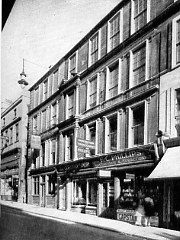
Westgate Street, houses, 1940s photo
Westgate Buildings is today made up of large department and discount stores selling practical items, above which are small apartments. In 1774, Ward's shop was relocated to the bottom, and in 1779 near the top, 22, of fashionable Milsom Street, two buildings down from 24, Pratt & Marshall's, a circulating library catering to the nobility, gentry, military and naval officers and clerics. Milsom is still a central fashionable shopping spine. It has still has banks, and Octagon Chapel, once a famous exclusive propriety chapel, the kind the Austens belonged to, is still there, though today housing a small commercial museum, coffee shop and video store. Towards the top too there are a few elegant shops, among which it is easy to imagine the printshop whose print depicting picturesque contemplation provided Austen's fictional Admiral Crofts such amusement as he gazed into its shopwindow:
'What queer fellows your fine painters must be, to think that anybody would venture their lives in such a shapeless old cockleshell as that? And yet here are two gentlemen stuck up in it mightily at their ease, and looking about them at the rocks and mountains, as if they were not to be upset the next moment, which they certainly must be. I wonder where that boat was built!' (laughing heartily) 'I would not venture over a horsepond in it . . . (P, II:6, p. 169)

Milsom Street, 1940s photo
The problem is there can apparently be no book specifying which houses Ann Ward Radcliffe lived in while at Bath -- or for how long during these same years she also resided with her wealthy maternal uncle, Thomas Bentley, who, with Josiah Wedgewood, ran a successful business in London selling expensive genuine antiques. No record of her life in Bath has come down to us, perhaps because she was ashamed of her position in its milieu. Her most recent biographer has rejected as legend the idea that between 1781 and 1783 she attended Belvedere House, Harriet and Sophia Lee's boarding school for girls, a handsome mansion, at the time previously an elegant hotel, on Lansdowne Road, which is located among the north hills of Bath. We saw it as a well- kept apartment building on a street running parallel to Paragon Buildings, curving up into Lansdowne Crescent. It's not so much that in 1781 Ann was seventeen, an age when most girls left school, as that she was the daughter of a tradesman, and Belvedere was very fashionable, expensive and filled with the daughters of aspiring and wealthy gentlemen: whatever the academic education on offer (French, writing, arithmetic, music, drawing and perhaps history), it in fact seems to have been sold to its clientele as a girls' school of just that seminary kind Austen's narrator in Emma (I:3, pp. 21-22) rejects as charging a great deal of money in exchange for instilling in girls a readiness to shine in social and polite rituals, and a belief in their self-consequence: its advertisements emphasised dancing and drawing lessons, 'purity of manners and self-respect taught by example'.
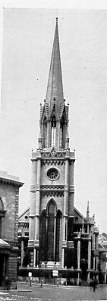
St Michaels, mid-20th century photo
All we know for sure is that at St. Michael's Church on Monday, 15 January 1787, 'Miss Ward, daughter of Mr Ward, in Milsom Street' was married to 'the Rev William Radcliffe, A. B. of Oriel College, Oxford', because the Bath Chronicle for Thursday, 18 January, tells us so.15 This parish church was a Georgian rebuilding of a medieval church, and has been torn down; its replacement, built in 1836, stands on the corner of North Gate and Broad Streets, a central intersection of the city through which also flows traffic from Walcott and Green Streets; across the way from it you see to your right the head Post Office of Bath, and to your left an underground parking garage. It is, though, appropriately for a writer of gothic romances, a Gothic revival church with a steeple on the outside and delicate high arched late medieval vaulting and slender pillars inside. A small Victorian replay of Salisbury Cathedral, its artwork is genuinely sympathetic to medieval ideals. On the day before we climbed Beechen cliff, that is, Wednesday, 15 March 2000, outside St. Michael's had been tumult, but inside had been tranquillity.16
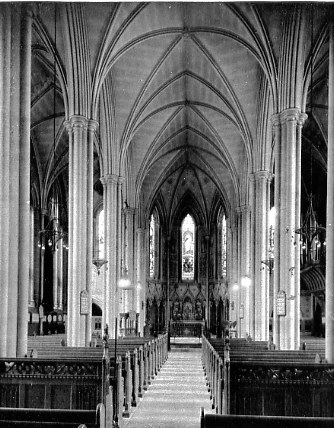
St Michaels, Gothic interior, 1940s photo
Contemplating the changes and continuities of Bath's topography with Austen's, Burney's and Radcliffe's actual lives in mind had dramatised the economic and social conflicts these three women knew and wrote about; contemplating these changes and continuities with Austen's, Burney's and Radcliffe's writing in mind had given real details with which more fully to imagine the actual past and landscape this writing is rooted in and its connection to the present. The mercurial nature of Radcliffe's biography and the way the places she was connected to seemed always to find their most concrete embodiment in Austen's and her own imaginative fiction highlighted a final aspect of these three women's lives in Bath, one whose importance cannot be overemphasised: the reality that this city, because it was experienced by these women as a place of leisure and a cultural mecca, provided them with the materials for a rich imaginative life through the availability there of books, prints and paintings, musical concerts, lively theatre and the landscape of the surrounding countryside.

Upper Assembly Rooms rebuilt after bombing, 1940s photo
This aspect of their experience is not, of course, something one can attempt any sort of literal re-enactment. One had to imagine Jane, Fanny and Ann reading and contemplating books and prints at Pratt & Marshall's or James Leake's, later (Lewis) Bull's, on Terrace Walk then opposite assembly rooms over their history successively denominated Harrison's, Simpson's and the Lower Assembly Rooms and demolished in 1933. In 1799, Hester Thrale, then Mrs Piozzi, wrote that Bull hates the very sight of me . . . because I come to his Shop at 8 or 9 o'Clock in the Morning . . . the only Leisure hour the Man has from Readers who sit round his Table all Noon and Footman who ferret after him for Novels all Night -- : and I make him clamber for me & reach Books which do not answer, & then he has to mount the Steps again, & so we go on . . . 17
One had to imagine them reading one of the guidebooks of the time, say J. Hassell, Ibbetson and Laporte's A Picturesque Guide to Bath, Bristol Hot-Wells, the River Avon, and the Adjacent Country (1793), which assured them that Midford Castle and its priory resembles
that about Tivoli; the rocks are no bad substitute for ruins, and a contemplative eye may wander from the terrace at Midford castle, till the imagination is transported into Italy. The solemn gloom of this enchanting spot, is accompanied by a repose and silence perfectly in harmony with it.
When in response to Catherine's comment as she and Henry Tilney walk along the Avon before ascending Beechen Cliff that 'I never look at [this countryside] without thinking of the south of France', Henry asks her 'a little surprized' whether she has been abroad, and she replies, Oh! no, I only mean what I have read about. It always puts me in mind of the country Emily and her father travelled through, in the Mysteries of Udolpho (NA I:14, p. 95), the contemporary reader's laughter would have been qualified by memories of many other picturesque travel books, and perhaps excursions too into places like Farley Castle, at the time a romantic ruin, with a tower swathed in ivy, complete with broken staircase, set high on a hill about six miles from Bath, and, in the larger surrounding region which includes Wells, abbeys like Lacock, Malmesbury and Glastonbury -- the last of which my husband and I visited in 1976, a genuinely Arthurian place of interest to medieval, literary and archealogical historians.18 It is, though, probable that Catherine was telling the simple truth not only for herself when she attributed her imaginative response to Beechen cliff to scenes she dreamed over in a book.19

The Abbey, view from northeast, 1940s photo
The circulating libraries, the eighteenth century theatre as it was then, the trade in glamorous paintings of the rich and famous, the exquisite music-making of the period are all mostly gone from Bath. We had done what we could in the few days we were there in the way of listening to music at the Abbey Church and in the Pump Room, going to the Costume and Building museums, to bookshops and the Victorian Art Gallery, and walks just beyond the city like our present one. Not far from the Upper Assembly Rooms, still standing, despite heavy bombing in 1942 which reduced them to a roofless shell after having been a cinema for a decade or so, today restored as a major tourist attraction, we found Brock Street, a quiet thoroughfare which contains three antiquarian bookshops -- an occasion which necessitated walking to the Post Office to mail off books back home.
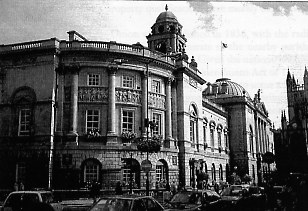
18th Guildhall, with Victorian extension, monument to Jerom Murch, seven times Mayor of Bath in Victorian period, 1940s photo
At the Victorian Art Gallery we had seen Thomas Rowlandson's watercolours, The Comforts of Bath (1798), and I had been able to see something of what these Upper Rooms had been like as an experience when in Northanger Abbey Austen's narrator had told the reader that Mrs Allen and Catherine had had to struggle 'by unweared diligence', fight their way through a packed crowd of people to gain 'the top of the room' and then 'by a continued exertion of strength and ingenuity had found themselves at last in the passage behind the highest bench' (NA I:3, p. 21). In a grotesque harshly satiric visualisation of such an experience, Rowlandson's 'The Dancing', to the upper right of a panoramic view of the Upper Assembly ballroom, filled with small figures dancing, playing musical instruments, mingling, and sitting uncomfortably on rows of chairs against the walls, one sees a reversed archway which resembles an upside-down soup bowl; above it, a panoply of indistinguishable tumbling writhing bodies packed into a shallow space.20
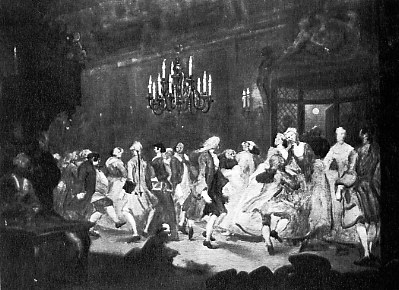
William Hogarth,
It was Thursday and the next day we were to leave Bath, to drive through Somerset, stopping at Wells, and then onto Shute Gatehouse, a renovated fifteenth-century gatehouse near Axminster, Devon, where we were to stay, and from which we intended to visit Lyme, Sidmouth, and if time permitted, Teignmouth. We thought also of driving to Honiton, Colyton and Exeter. Now we walked down the cliff, this time going round. Looking more carefully at Austen's text, one sees they went round . . . a few thoughts. It was warm sunny day. White light. Cool mist. A landscape that spread out from under Beechen Cliff.

Late Medieval: St Catherine's Church, 1940s photo
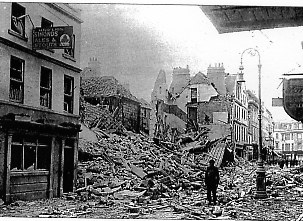
Twentieth Century: Bombing of Kingsmill area, 1940s photo
1 Isabel Colegate, The Summer of the Royal Visit(London, 1991), pp. 3-4. L. P. Hartley, The Go-Between (1953; reprint New York, 1997), p. 5.
22 Jean-Jacques Rousseau, Rêveries du promeneur solitaire, ed. H. Roddier (Paris, 1960); Rebecca Solnit, Wanderlust: A History of Walking (New York, 2000), pp. 3-4.
3 Page references to Jane Austen's novels, letters and verses are given in the text. The editions and abbreviations used are: The Novels of Jane Austen, ed. R. W. Chapman (3rd edn., 5 volumes, Oxford, 1942-44): E, Emma; P, Persuasion; MP Mansfield Park; P&P, Pride and Prejudice; NA, Northanger Abbey; S&S, Sense and Sensibility; MW, The Works of Jane Austen, vi, Minor Works, ed. R. W. Chapman (Oxford 1954); Letters, Jane Austen's Letters, collected and edited by Deirdre Le Faye (3rd Edition, New York, 1995); Collected Poems, The Poetry of Jane Austen and the Austen Family, ed. David Selwyn (Iowa City, Iowa, 1997).
4 John Wood, A Description of Bath (1765; reprinted Bath, 1969), pp. 52-55, quoted from again below. See my review of Peter Borsay's The Georgian Image of Bath. I include a select bibliography of major books on Bath.
5 See, for example, Anne-Marie Edwards, In the Steps of Jane Austen (Newbury, Berkshire, 1991); Kirsten Elliot, A Window on Bath: Eight Walks in Bath(Bath, 1994); Mavis Batey, Jane Austen and the English Landscape(London, 1996).
6 See Walter Ison, The Georgian Building of Bath from 1700 to 1830 (London, 1968) and R. S. Neale, Bath: A Social History 1680-1850, or A Valley of Pleassure, yet a Sink of Inquity (London, 1981).
7 Scholars differ on whether the Austen lived at 3 or 27, Green Park Buildings. Older sources tend to give it as 3, newer as 27; some simply say Green Park. Both are part of the same block which includes 12, Green Park, originally rejected by the Austens as too damp, even if more affordable than other dryer desirable places. The list of places the Austens also simply thought about living in and researched into over the years cannot be fully reconstructed with precise clarity as it is too complicated and vaguely expressed in the remaining documents we have. See, for example, Letters, pp. 66-67, 86-88.
8 The primary documents from which I quote from this letter by Mrs Austen, Pedigree of Austen/Austen Papers, 1704- 1856, ed. Richard A. Austen-Leigh, introduced by David Gilson (1940; reprinted London, 1995), will be cited in my text as Austen Papers.
9 This is Maggie Lane's invaluable A City of Palaces: Bath Through the Eyes of Fanny Burney (Bath, 1999). Using this book, the interested reader can also locate the buildings where Fanny's sisters and other close relatives lived while in Bath.
10 George Austen's profession, way of life, and the education and positions he sought for his sons and daughters epitomise the strata of society the historian Alan Everitt had aptly described as pseudo-gentry; see David Spring, 'Interpreters of Jane Austen's Social World: Literary Critics and Historians', Jane Austen: New Perspectives, ed. Janet Todd (New York, 1983), pp. 59-61.
11 James L. Clifford, Hester Lynch Piozzi (Oxford, 1952), pp. 3-52.
12 See John Penrose, Letters from Bath, 1766- 1767, edd., introd. and notes Brigitte Mitchell and Hubert Penrose (Gloucester, 1983). Penrose, of whom and his adventures much more below, stayed in the building which still stands next to Elton House. We could see his window from our second floor.
13 See Maggie Lane, A Charming Place: Bath in the Life and Novels of Jane Austen (Bath, 1993), pp. 39-40.
14 Clive Caplan, 'Jane Austen's Banker Brother: Henry Thomas Austen of Austen & Co., 1801-1816', Persuasions, 18 (1998), pp. 69-80; Park Honan, Jane Austen: The Definitive Portrait of Her Life, Her Art, Her Family, Her World (New York, 1989), pp. 68-69, 442-43; Claire Tomalin, Jane Austen (New York, 1997), pp. 276-78.
15 Rictor Norton, Mistress of Udolpho: The life of Ann Radcliffe (London, 1999), pp. 22-57. See also Sophia Lee, The Recess, ed. and introduced by April Alliston (Lexington, Kentucky, 2000), pp. xxviii-xxxii. See Georges Lamoine, La Vie Litteraire de Bath et de Bristol, 1750-1800, 2 Volumes (Paris, 1978), ii, p. 674; Devendra P. Varma, The Evergreen Tree of Diabolical Knowledge (Washington, D. C., 1972), p. 180.
16 There are some good photographs in Bryan Little, The Building of Bath, 47 - 1927: An Architectural and Cultural Study (London, 1947), Plates 109 and 111.
17 Clifford, Hester Lynch Piozzi, p. 398; Trevor Fawcett, Bath Entertain'd: Amusements, Recreations and Gambling at the 18th Century Spa (Bath, 1998), pp. 24-25; Walter Ison, The Georgian Building of Bath from 1700 to 1830, pp. 49- 50.
18 Norton, pp. 51-52; C. A. Ralegh Radford, 'Glastonbury Abbey' and Philip Ratz, 'Glastonbury Tor', The Quest for Arthur's Britain, ed. Geoffrey Ashe (Aylesbury, 1976), pp. 97- 122.
19 A extremely popular book of the type filled with pictures of castles, abbeys, priories and the landscape around Bath and Wells was Samuel and Nathaniel Buck's Buck's Antiquities; or, Venerable Remains of above Four Hundred Castles, Monasteries, Palaces, &c &c. in England and Wales (1774).
20 For an excellent description and commentary on the set, see Ronald Paulson, Rowlandson: a new interpretation (New York, 1972), pp. 8-9, 45-70.

Page Last Updated 9 July 2004